Innovation is happening in the world of stem cell research, particularly in engineering organoid cultures and tissue regeneration. However, using an extracellular matrix derived from biological collagen drastically limits the opportunity for research and development. The alternative? A stable, synthetic extracellular matrix that’s uniquely designed to support cell cultures. PEG hydrogels could replace most animal-based matrices – eliminating those limitations.
Creative PEGWorks developed a multi-arm PEG reagent that has successfully replaced animal-derived matrices. The Swiss research team from L’Ecole Polytechnique Fédérale de Lausanne (EPFL) can attest to its benefits and practical applications. Let’s look more closely at this study to see how 8-Arm PEG-Acrylate has solved the limitations of biological matrices.
Manufacturing a Custom Synthetic Extracellular Matrix
The Swiss research team from L’Ecole Polytechnique Fédérale de Lausanne (EPFL) needed to find a solution to the limitations of using animal-derived matrices when studying and engineering cell growth. They sought out a more innovative solution, so they looked to find a manufacturer of synthetic extracellular matrices.
Creative PEGWorks manufactures multi-arm PEG reagents that can be used for this exact purpose. The research team contacted the biotech manufacturer, making use of the custom PEG synthesis offering to make use in their research. The team needed a synthetic material, or custom matrix, that would support epithelial organoids – and Creative PEGWorks delivered.
The team recently published their findings in Nature, a leading scientific journal. Specifically, they reported the first intestinal and colorectal cancer organoid culture in a fully defined synthetic extracellular matrix.
How Extracellular Matrices Help Future Research
Epithelial organoids are able to emulate many aspects of other organs, which makes them ideal for modeling organ development, function, and disease. The modular hydrogel with defined parameters within the matrix creates a better environment to support intestinal stem cell (ISC) expansion and organoid formation at every stage of development. This means researchers can more accurately observe and experiment on developing cellular structures instead of having to work around the limitations of growing cell cultures in an extracellular matrix derived from animal collagen.
The data collected during this experiment allowed the team to engineer a fully-defined culture system using multi-arm PEG reagents. The same methods they used can be applied to other designer extracellular matrices for other stem cell and organoid cultures, even beyond ISC.
What Is an Extracellular Matrix?
An extracellular matrix is a 3-dimensional network of macromolecules, proteins, and minerals that provide structural support to cells and tissues in the body. A synthetic matrix is an external environment that emulates biological systems. Researchers commonly use extracellular matrices when researching diseases and cellular growth patterns – like in cancer research.
Also called the ECM, these mock networks facilitate attachment and communication with nearby cells. They are essential to the growth, movement, and repair of the cell. Abnormal changes in the ECM can lead to cancer cells developing, and the ECM of cancer cells can also affect how the disease grows within the body.
In research, the most commonly used extracellular matrix consists of animal collagen and proteins. However, these animal-derived biological matrices are difficult to use, particularly when aiming to maintain stasis or repeat results.
Innovation in Developing a Synthetic Extracellular Matrix
The development of this designer structure started with an enzymatically crosslinked PEG hydrogel that was used to modulate 3D synthetic networks which support organoid formation.
Why was this approach so novel? This was the first time a modular hydrogel with defined parameters within the matrix was used to create a more suitable environment to support intestinal stem cell (ISC) expansion and organoid formation at every stage of development. This innovative approach overcomes multiple limitations of current organoid cultures and greatly expands its applicability in basic and clinical research.
How PEG Hydrogels Can Transform the Future of Cancer Research
By using a multi-arm PEG reagent, or a synthetic extracellular matrix, rather than biological, collagen-based, or animal-derived matrices, researchers can see multiple benefits, including:
- Better accuracy due to more consistent and repeatable conditions.
- Fewer potential for unknown protein composition that could complicate results.
- Greater ability to customize the ECM to support cell cultures.
In cancer research, repeatable results can lead to significant findings and correlations. The more sterile and synthetic environment eliminates many of the variables caused by the inconsistencies caused by using animal-derived matrices. This type of environment leads to more accurate data, faster results, and an improved understanding of cellular growth, behavior, and treatment.
Contact Us for Multi-Arm PEG Reagents for Extracellular Matrices
Creative PEGWorks congratulates this significant advancement in PEG hydrogel and their use in regenerative medicine. They are proud that their multi-arm PEG reagents (e.g. 8-Arm PEG-Acrylate) was used in this great achievement.
If you would like to learn more about multi-arm PEG reagents and how PEG hydrogels can help you create your own extracellular matrix for biomedical applications, reach out to us today. We manufacture and supply custom synthesis orders as well as a wide selection of PEG products online. We even ship overnight! Call us at [phone] or visit our website to place an order.
Interesting Related Article: “How Close Is Science To Curing All Cancers?“



_labeled_with_fluorescence_dyes-Vshivkova_9fc952884c46485589d5e3d9bff007e5-620x480.jpg)
